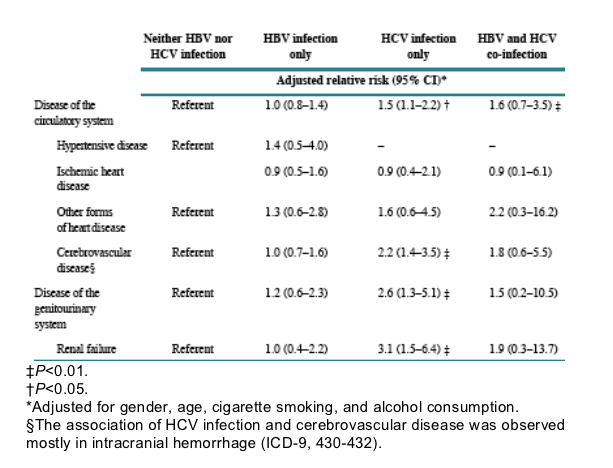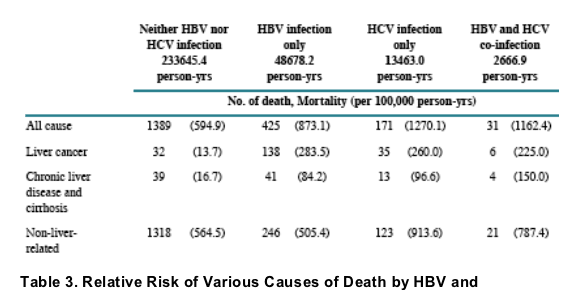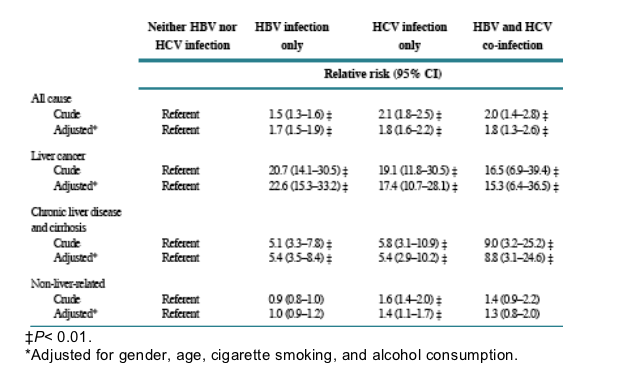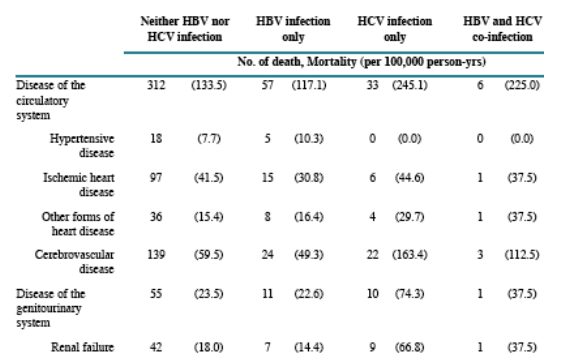 |
 |
 |
| |
Causes of Death Associated With Hepatitis B or Hepatitis C Virus Infections
in a Long-Term Population-Based Cohort Study
|
| |
| |
Reported by Jules Levin
Digestive Disease Week 2007, Washington Convention Center, Washington, DC, May 19-24, 2007
H-I Yang1,2, C-J Chen1,2, C-L Jen1,2, UH Iloeje3, J Su3, S-L You1,2
1Genomics Research Center, Academia Sinica, Taipei, Taiwan; 2National Taiwan University, Taipei, Taiwan; 3Bristol-Myers Squibb Pharmaceutical Research Institute, Wallingford, CT, USA
Chronic infections with HBV or HCV are well-documented risk factors for cirrhosis and HCC; cirrhosis develops in 20% and 10% to 15% of patients with chronic HBV and HCV infections, respectively.1,2 The yearly incidence of HCC is 2.5% in HBsAg-positive cirrhotic patients and 1% to 4% in cirrhotic patients with chronic HCV infection2,3
In this study, we report on the association between chronic HBV and HCV infections and mortality, including liver-related deaths and those associated
with extra-hepatic diseases
Author Conclusions
Subjects with HBV, HCV infections and HBV/HCV co-infection had elevated risk of liver-related mortality compared to subjects without HBV or HCV infection
HCV infection may be associated with death from several extra-hepatic manifestations such as cerebrovascular disease (mainly intracranial hemorrhage) and renal failure, which may result from cryoglobulinemia and membranoproliferative glomerulonephritis4,5
Table 5. Relative Risk of Diseases of Circulatory and Genitourinary
Systems by HBV and HCV Infection Status
Risk for certain diseases were higher for patients with HCV compared to those with HBV (cerebrovascular, diseases of the genitourinary system, and renail failure). Patients with both HBV & HCV also had increased risk compared to those with HBV but not more and sometimes less than for those with HCV alone.

*Adjusted for gender, age, cigarette smoking, and alcohol consumption.
§The association of HCV infection and cerebrovascular disease was observed mostly in intracranial hemorrhage (ICD-9, 430-432).
Table 2. Mortality Rate According to HBV and HCV Infection Status
Mortality rates were higher for HCV+HBV infected than HCV or HBV infected due to chronic liver disease and cirrhosis; mortality rate due to non-liver related cause was higher for HBV+HCV infected than for HBV infected but lower than HCV infected.

Patients with HCV+HBVhad higher rates for chronic liver disease and cirrhosis compared to patients with HCV or HBV alone.

Table 4. Mortality Rate of Diseases of Circulatory and Genitourinary
Systems by HBV and HCV Infection Status
HCv was associated with highest mortality rates due to renal failure; HCV+HBV had higher rates of renal failure than HBV-infected. Ischemic heart disease and cerebrovascular mortality rates, and other forms of heart disease were higher for patients with HCV than for patients with HCV.

STUDY DESIGN
Population-based cohort study
--A total of 89,293 adult residents of 7 townships in Taiwan aged 30 to 65 years were invited to participate in 1991 and 1992
-- 23,820 (27%) subjects agreed to participate, gave informed consent, and were enrolled in the cohort
At enrollment, subjects:
-- Provided written informed consent
-- Underwent a structured questionnaire interview by a trained public health nurse
-- Provided a serum sample which was separated on the day of collection and frozen at -70ºC
-- 23,785 subjects with adequate serum sample tested for HBsAg and anti- HCV (35 subjects lacked adequate serum sample for anti-HCVtesting)
Methods
- Laboratory methods:
- HBsAg by radioimmunoassay (Abbott Laboratories, North Chicago, IL)
- Anti-HCV by 2nd generation ELISA kits (Abbott Laboratories, North Chicago, IL)
- Vital status was ascertained through computerized data linkage with National Death Certificate Registry in Taiwan from January 1, 1991 through December 31, 2004
- In Taiwan, all deaths are registered through the nationwide system of household registration office. These death certificates are coded by Taiwan Department of Health and computerized since 1971
- The classification of cause of death was based on the International Statistical Classification of Diseases, Injuries and Causes of Death (Ninth revision)
- Malignant neoplasm of the liver and intra-hepatic bile duct: code 155
- Chronic liver disease and cirrhosis: code 571
- Diseases of the circulatory system: code 390-459; hypertensive disease: code 401-405; ischemic heart disease: code 410-414; other forms of heart disease: code 420-429; cerebrovascular disease: code 430-438
- Disease of genitourinary system: code 580-629; renal failure: code 584 and 586
- Data analysis was based on time-to-event methods
- Person-years of follow-up was calculated from enrollment data to date of death, or date of the last link to the National Death Certificate Registry (December 31, 2004)
- Survival curves by follow-up year were derived by the Kaplan-Meier method
- Cox proportional hazards models were used to estimate multivariable adjusted relative risk of mortalities associated with HBV/HCV infection status
References
1. Ganem D, Prince AM. Hepatitis B virus infection-natural history and clinical consequences. N Engl J Med. 2004;350:1118-1129.
2. Shaw-Stiffel T. Reference to Hepatitis C Infection. London: Science Press; 2004.
3. Beasley RP, Hwang LY, Lin CC et al. Hepatocellular carcinoma and hepatitis B virus. A prospective study of 22,707 men in Taiwan. Lancet. 1981;2:1129-1133.
4. Khella SL, Sauayah N. Hepatitis C: a review of its neurologic complications. Neurologist. 2002;8:101-106.
5. Daghestani L, Pomeroy C. Renal manifestations of hepatitis C infection. Am J Med. 1999;106:347-354.
|
| |
|
 |
 |
|
|